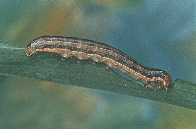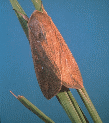Armyworms in Small Grains
ENTFACT-111: Armyworms in Small Grains | Download PDF
by Doug Johnson, Extension Entomologist
University of Kentucky College of Agriculture

Armyworm Larva
The armyworm, also known as true armyworm, is a common early season pest that occasionally cause catastrophic losses in small grains. Armyworms should be monitored for in the spring. Typically, moth flight will begin in early to mid April and larvae will appear from late April to early May. Infestations usually develop first in very thick and lodged stands.
The name armyworm derives from its behavior of migrating in large numbers into fields similar to invading armies. Cool, wet, spring weather usually favors armyworm development.

Armyworm Moth
The full-grown 1-1/2 inch armyworm has a greenish brown body with a thin stripe down the center and two orange stripes along each side. The head is brown with dark honeycombed markings. Eggs are small, greenish-white, globular, and laid in clusters of 25 or more on the leaves of grasses. The adult moth is tan with a tiny white spot in the center of each forewing. The moth has a wingspan of about 1-3/4 inches.
Armyworms overwinter as partially grown larvae in grasses or small grain fields. When warm spring temperatures return, armyworm feeding resumes. When feeding is completed, larvae pupate just below the surface of the soil. Adults of the first generation emerge in April and May and feed on nectar for 7 to 10 days before beginning to lay eggs. There are three to four generations per year in Kentucky.
Armyworms usually feed at night and damage small grains by chewing leaves. They prefer to feed on the succulent leaves near the top of the plant. Feeding is usually confined to leaf margins, but occasionally they may strip the entire plant. Occasionally, armyworms will clip the heads from maturing plants. Though this is not the normal case, when it happens the resulting loss in yield can be quite substantial. During the day, armyworms are found in the soil or underneath ground cover. Small grains can usually recover from light to moderate feeding by armyworm without significant yield loss. However, severe damage, can cause significant loss in yield.
Treatment recommendations are based on scouting. Scouting is used to determine if armyworms are present (identify hot spots) and to evaluate if they are worth treating. If the characteristic armyworm damage is observed while scouting, look on the ground for armyworms or their black pepper-like droppings. Remember, during the day, armyworms hide in soil cracks or under clods and crop residues. Occasionally, especially during a heavy overcast, they may be found on the plant during the day, however, they usually feed at night. To sample for armyworms, examine a 4 square foot area in at least 5 random locations in the field. Count the number of larvae between 1/2 and 3/4 inches long. Also, do not count larvae that are obviously parasitized or diseased.
When scouting,check the backs of armyworms, for eggs. These small, oval, yellowish eggs are usually located just behind the head of the larva. These are eggs of a parasitic fly. Fly maggots that will hatch from these eggs and ill the armyworm larvae. These parasites and other beneficial organisms usually keep armyworms from reaching damaging levels. Avoid treating with insecticides when large numbers of parasitized larvae are present.
Before deciding whether or not to treat for armyworms with an insecticide there are a few things to consider. First, what size are the armyworms. If the armyworms are longer than about 1-1/4 inch they have completed most of their feeding. Controlling larvae of this size is not profitable because the damage is already done. Control actions in small grains are recommended when scouting finds on average 16 armyworms, between 1/2 and 3/4 inches in length, per 4 square feet.
Pheromone traps are available to monitor adult armyworm activity. See ENT-54, Vendors of Microbial and Botanical Insecticides and Insect Monitoring Devices, for a list of vendors of the armyworm lures. Although armyworms can be captured in the small, cardboard, wing traps, the Texas wire cone trap (ENTFACT-010, Plans and Parts List for the "Texas" Style Cone Trap for Monitoring Certain Insect Pests) is recommended. Armyworm moths are common throughout the season and are frequently captured in pheromone traps baited for other moth species.
Preventive treatments for armyworms are not justified. Although it may appear as if the preventive treatments are very effective, in fact the likelihood that a particular field will have an outbreak of armyworms is very small. Additionally, most "preventive treatments" are made because of the convenience of applying the insecticide while doing some entirely unrelated practice, (for example, applying herbicide or fertilizer). The long-lasting insecticides of the past are gone. Today, pest control requires as much accuracy in the timing of the application as it does in selecting the product or equipment.
Keep in mind that a majority of fields will have some armyworms in most years, but the chance of encountering an infestation that economically justifies the cost of treatment is quite small. Only rescue treatments are recommended for armyworms in small grains. Additionally, spot treatments can usually provide effective control of localized infestations like field-margins.
References
- Johnson, D. Using Pheromone Traps in Field Crops (ENTfact-112).
- Johnson, D. Vendors of Microbial and Botanical Insecticides and Insect Monitoring Devices. ENT-54.
- Johnson, D. and S. McNeill. Plans and Parts List for the "Texas" cone trap for Monitoring Certain Insect Pests (ENTfact-010).
Revised: 1/94
CAUTION! Pesticide recommendations in this publication are registered for use in Kentucky, USA ONLY! The use of some products may not be legal in your state or country. Please check with your local county agent or regulatory official before using any pesticide mentioned in this publication.
Of course, ALWAYS READ AND FOLLOW LABEL DIRECTIONS FOR SAFE USE OF ANY PESTICIDE!
Photos courtesy Ric Bessin, University of Kentucky Entomology
